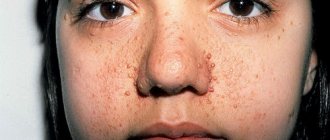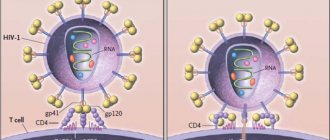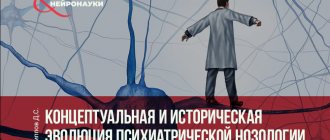Full text of the article:
The Russian calendar of recommended vaccinations includes vaccination against
polio.
There are various drugs that could be used for vaccination. Doctors could vaccinate children using inactivated, “live”
or
combined vaccines
. Nowadays, live vaccines are mainly used for vaccination, but what caused such changes?
Why is polio dangerous?
Poliomyelitis is also called “ infantile spinal paralysis.”
”, since polio mainly affects children under 6 years of age.
Polio is highly contagious. The disease is provoked by a polyvirus
, which can be transmitted both by
airborne droplets
and
by household contact
. You can become infected with polio through contact with a sick person or through contaminated food, water and objects.
Polyvirus can be very tenacious. If there is no suitable “carrier” nearby, the virus easily adapts to the environment and can remain active for six months
, it is not afraid of drying or freezing, so it can live in almost any climate.
A person who has become infected with polio can survive the disease without visible symptoms, but throughout this time he will be dangerous to others. Regardless of the presence of symptoms, a sick person is a carrier and distributor of the infection. The main danger of polio is that it affects the membrane of the spinal cord
, and with it
motor nerve cells
, which leads to their death. Poliomyelitis can cause paralysis of certain muscle groups and lead to their atrophy, as a result of which a person becomes disabled.
Symptoms of polio and course of the disease
The polio virus causes the following symptoms:
- signs of intoxication: nausea, vomiting, diarrhea, rash;
- cold-like disorders: cough, runny nose, sore throat, difficulty breathing and swallowing;
- fluctuations in blood pressure, fatigue, general poor health, headache;
- in rare cases - various types of paralysis that can lead to the death of the patient.
It is important to note that in 90% of cases, polio has no symptoms and does not affect the nervous system. And in 10% of cases there are very severe forms, involving inflammation of the membranes of the brain - with serious consequences, even fatal.
The incubation period of polio is quite short - it does not exceed 5 days. In this case, recovery in the case of a mild form occurs within 3 days. However, as we have already said, there are also complex forms - they are quite rare, but extremely dangerous. In this case, treatment may last for months, years, or may be completely useless.
Are you experiencing symptoms of polio?
Only a doctor can accurately diagnose the disease. Don't delay your consultation - call
Fighting polio
Outbreaks of polio periodically occur in different parts of the world. An active fight against the disease took place in the middle of the last century in Europe and North America, and then an effective vaccine against the virus was created. In the USSR, children were actively vaccinated against polio, so by 1961 the disease was defeated
.
For almost half a century, doctors in the Soviet Union and then in Russia did not encounter new cases of the disease, but in 2010, an outbreak of polio was recorded in Tajikistan
.
Then about 700 people became infected with the virus, and 26 of them died. Quite quickly, the virus penetrated into Russia, and it turned out to be a “ wild strain
” of the virus, which had previously been found only in India, Pakistan and Afghanistan. It was decided to reconsider the approach to vaccination.
What vaccination is given against polio?
Parents often ask at what age is the polio vaccine given? A doctor can answer this question, since much depends on the vaccination plan and what drug is used for vaccination. Until 2010, not a single case of polio was recorded in Russia, so children were vaccinated using an inactivated vaccine
, which did not contain live viruses.
Injections of the drug were given to the child in the first two years of life
, and then revaccination was carried out
at the age of 14
. Unfortunately, inactivated, i.e. The “dead” vaccine is not capable of providing a child with protection against the “wild strain” of polio, so they decided to replace the inactivated vaccine with a “live” one.
The “live” vaccine contains live but weakened viruses.
, it is believed that a live vaccine helps the body develop the necessary immune response to the “wild strain” of the polyvirus.
However, a live vaccine is not used throughout the entire vaccination course; the first two vaccinations for babies are still given using an inactivated vaccine
.
Features of the childhood vaccination scheme in Russia and the world
There are two types of polio vaccines:
- IPV, i.e. inactivated polio vaccine (with killed virus),
- OPV, i.e. oral polio vaccine (live, with a weakened virus, so-called attenuated).
Live may contain one individual or a combination of strains of the 1st, 2nd or 3rd type of poliovirus types. And the inactivated one can be single-component (only for polio) or be part of combination drugs for several infections.
IPV is administered intramuscularly or subcutaneously and is considered safer than OPV because... does not carry any risk of developing vaccine-associated paralytic poliomyelitis. Possible side effects after IPV injection: redness (0.5–1%), induration (3–11%) and soreness (14–29%) at the injection site.
OPV, unlike IPV, comes in the form of drops and is administered orally, that is, through the mouth. The effectiveness of OPV is close to 100%. The main advantage of the live vaccine is the ability to form a local immune response in the intestines, which makes it impossible for wild polioviruses to multiply in the body of vaccinated children.
ON A NOTE! A vaccinated child releases the vaccine virus into the environment for up to several weeks. The vaccine virus can be transmitted from a child vaccinated with OPV to unvaccinated children through dirty toys and dishes, protecting them too. Scientists have also identified an interesting effect of OPV vaccination - the development of nonspecific immunity, which reduces mortality in general.
The main disadvantage of OPV is the existing possibility of a complication - vaccine-associated polio (VAPP), which is no different from wild infection. The disease is rare (one child out of 1-1.5 million vaccinated children and one out of 14 million contacts). At risk are children who are not vaccinated at all, with an irregular schedule or immunodeficiency, but who are in contact with recently vaccinated people, as well as those who immediately received a live drug without prior administration of an inactivated one.
ATTENTION! Even one dose of an inactivated drug before vaccination with a live virus eliminates the occurrence of vaccine-associated paralytic poliomyelitis.
Scientists have long known about the nuances of these vaccines, and have found a solution. To reduce the risk of VAPP, polio is first vaccinated using IPV, and only then a live vaccine (OPV) is included. This tactic has been in effect according to WHO recommendations for all countries since 2016, and has existed in Russia since 2008. In our country, such sequential vaccination (2 doses of IPV + 1 dose of OPV, subsequent revaccination with OPV) helped reduce the number of VAPP cases by 2.6 times.
Isolation of vaccinated children is an important condition for prevention. Children who have been vaccinated with an attenuated vaccine should be isolated from those who have not been vaccinated or who have been vaccinated less than three times. This requirement is enshrined in the legislation of the Russian Federation in the Decree of the Chief Doctor of Russia, and applies to all institutions in which children are located.
The isolation period is 60 days after vaccination. How this happens, who needs to be isolated and from whom - these issues are resolved on the spot by parents, educators, doctors, and so on. Despite the fact that vaccine-associated polio is not so common, ignoring prevention recommendations, according to experts, can lead to a new increase in incidence and outbreaks of the epidemic.
Also in 2021, they stopped using three-component OPV, because the 2nd type of wild poliovirus was completely exterminated. It was this component that caused a greater risk of VAPP (40% of cases). The vaccine used in Russia now contains not 3, but 2 strains (hence the “Bi” particle (lat. bi... two (x)) in the name: BiVac-Polio).
So, in Russia, vaccination against polio occurs according to the following scheme:
1. IPV vaccination is given twice by injection at 3 and 4.5 months; 2. third vaccination - in six months with a live vaccine in the form of drops (OPV); 3. at 18 and 20 months, the first and second revaccination with a live vaccine (OPV again); 4. at the age of 14, the third revaccination with live vaccine (OPV) is carried out.
At the same time, for some children, according to indications, all vaccinations are given with an inactivated vaccine.
It is important to note that in the case of polio vaccination, there are often cases of schedule violations when children ultimately do not receive all vaccinations according to the approved schedule. This may be due to the child’s illness (medical issues), or to the reluctance or doubts of the parents (“to do it or not”). Sometimes parents purchase the wrong vaccine; for example, they prefer to vaccinate against several diseases at once with a combination drug. In this case, it turns out that the child is not vaccinated with a live vaccine a sufficient number of times.
Should we be afraid of the “live” vaccine?
Some parents are afraid to vaccinate their child with a live vaccine because they believe that it can provoke the development of a real disease
, however, the fears are unfounded.
In some cases, complications may indeed occur after administration of the vaccine, but these are usually local allergic reactions that have nothing to do with polio. In addition, the first two vaccinations for a child are given using an inactivated vaccine
, this allows one to develop immunity from the strains of the virus that are in the live vaccine and avoid complications. After the first two vaccinations, the live vaccine can be used without risk.
This vaccination scheme is not new or experimental; it has been successfully used in different countries for many years. WHO also noted its effectiveness. However, in some cases, doctors still refuse to use a live vaccine. This happens when we are talking about babies with HIV infection or children who were born to HIV-infected parents. Also, children with primary immunodeficiency are not vaccinated with a live vaccine.
Domestic or imported polio vaccine: which is better?
All Russian immunobiological preparations for active immunoprophylaxis of poliomyelitis are represented only by live oral polio vaccines.
To prevent polio, foreign manufacturers produce and actively use only inactivated mono- and polyvaccines:
- single-component immunobiological agents - contain the full composition of virus strains, act carefully, are recommended for vaccination even of premature and weakened infants, and are ideally combined with other biological products: the Belgian development of Imovax Polio, the French Poliorix;
- multicomponent immunobiological agents are developed on the basis of pertussis-diphtheria-tetanus (DPT) vaccine and supplemented with biological material to form immunity to other infections. Tetrakok (France) - protects against four infections at once: DPT, polio, Pentaxim (France) - against five: DPT, polio, hemophilus influenzae infection, Infanrix Hexa (Belgium) - against six: DPT, polio, hemophilus influenzae infection, viral hepatitis B.
The advantages of polyvaccines include the convenience of their use: with one injection they protect against several dangerous infectious diseases at once.
It is difficult to say for sure which vaccine is preferable to vaccinate a child with - Russian or imported. Domestic biological products are more effective, but their use remains likely to cause vaccine-associated poliomyelitis.
Developments by foreign specialists based on inactivated strains are safer, but are inferior in effectiveness to live vaccines.
How can you tell which polio vaccine your doctor is using?
The pediatrician gives parents information about which vaccine will be used for vaccination and why. He also answers all questions about the vaccine and the drug, talks about possible reactions of the body and the recommended vaccination schedule. But you can distinguish an inactivated vaccine from a live one without the help of a doctor; you just need to look at where the polio vaccine is being given.
The inactivated vaccine is administered to the child using a syringe.
, and
live ones are dripped into the mouth
. The first vaccinations must be given to a child under 6 months of age, then the vaccine can be replaced with a live one. It is important that all vaccinations are done on time, then there will be no fear of the live vaccine, and even the disease itself.
How is polio diagnosed?
If obvious symptoms of polio occur, the patient is admitted to an infectious diseases hospital, where an infectious disease specialist takes over the examination. To understand what the reason is, they carry out a number of manipulations, be sure to investigate:
- blood and urine tests;
- materials from the nasopharynx;
- feces;
- cerebrospinal fluid.
All this allows us to find out which pathogen caused the disease and make a correct diagnosis.









